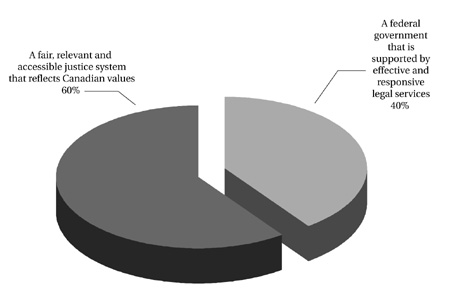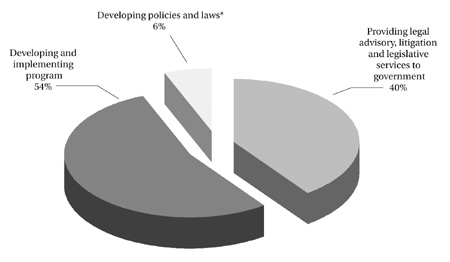Common menu bar links
Breadcrumb Trail
ARCHIVED - RPP 2007-2008
Department of Justice Canada
 This page has been archived.
This page has been archived.
Archived Content
Information identified as archived on the Web is for reference, research or recordkeeping purposes. It has not been altered or updated after the date of archiving. Web pages that are archived on the Web are not subject to the Government of Canada Web Standards. As per the Communications Policy of the Government of Canada, you can request alternate formats on the "Contact Us" page.
SECTION I – OVERVIEW
Message from the Minister of Justice
 The Department of Justice plays an important and unique role in the federal government and in Canada's justice system. Over the past year, the Department has focused much attention and energy on tackling crime—one of the Government's five priorities. In
the coming fiscal year, we will build on this progress and work toward a justice system that is more accountable, effective, accessible, and responsive.
The Department of Justice plays an important and unique role in the federal government and in Canada's justice system. Over the past year, the Department has focused much attention and energy on tackling crime—one of the Government's five priorities. In
the coming fiscal year, we will build on this progress and work toward a justice system that is more accountable, effective, accessible, and responsive.
More recently, with the passage of the Federal Accountability Act, the Government has taken a major step toward making public administration more open and transparent, as well as more accessible.
One key element of the new Act was the creation of the Public Prosecution Service of Canada (PPSC). The PPSC will have independence to pursue prosecutions under federal law and will report to Canadians on its performance. It is important for transparency and for the integrity of the federal justice system that prosecutions under federal law operate independently of the Attorney General of Canada and of the political process. The establishment of the PPSC will have a direct impact on the Department of Justice and its work. While some details will need to be addressed during the transition, the Department will continue to support me in working to ensure that Canada is a just and law-abiding society with an accessible, efficient and fair system of justice while providing high-quality legal services and counsel to the government and to client departments and agencies as well as promoting respect for rights and freedoms, the law and the Constitution.
We will also continue to work closely with our colleagues throughout the justice system to ensure an efficient system. In this regard, the Department has begun reviewing recommendations from the Steering Committee on Justice Efficiencies and Access to the Justice System. The Committee is composed of six Deputy Ministers of Justice from the federal and provincial levels, six representatives of the Judiciary and three members of the private bar. The Committees recommendations touch on issues such as mega-trials, and early case consideration among others.
An effective justice system has to be responsive to the concerns of the public. For example, most recently, the Government has introduced several initiatives to enable victims to be better heard within the system, and further ideas will be explored in the coming year, including the establishment of a Federal Ombudsman for Victims of Crime.
In the same way, we will continue to respond to the public's concerns by pursuing our mandate of tackling crime. Legislation to deal with the reckless and dangerous practice of street racing is now in force. The Department will continue to provide support for legislation already brought forward on a number of issues: conditional sentencing, mandatory minimum penalties for serious gun crime, DNA identification, raising the age of protection, reforming bail provisions for offences involving firearms, strengthening laws against drug- and alcohol-impaired driving, and strengthening sentencing for dangerous offenders. In addition, more work will be done toward developing a new national drug strategy.
At the departmental level, work will continue on issues such as sustainable funding for legal services, managing the volume of litigation, legal risk management, performance measurement, and developing the skills and knowledge of our workforce.
My Department has been fortunate to have the cooperation and support of many partners, including other departments and levels of government, the bench and the bar, the police, and others involved in the courts and the law enforcement community. I look forward to working together over the coming year to address these challenges and improve the justice system in Canada.
Robert Douglas Nicholson
Minister of Justice and Attorney General of Canada
Message from the Deputy Minister
 The Department of Justice strives for excellence in the practice of law. It is a leader in Canada and internationally and at the forefront of legal issues that are relevant to the daily lives of Canadians. The Department helps the federal government to develop policy and
to draft and reform laws as needed so that priorities and key commitments are realized to the benefit of all Canadians. In support of the Minister and the Government, the Department will focus on three priorities over the next fiscal year:
The Department of Justice strives for excellence in the practice of law. It is a leader in Canada and internationally and at the forefront of legal issues that are relevant to the daily lives of Canadians. The Department helps the federal government to develop policy and
to draft and reform laws as needed so that priorities and key commitments are realized to the benefit of all Canadians. In support of the Minister and the Government, the Department will focus on three priorities over the next fiscal year:
- An effective and accessible justice system;
- Protecting Canadian communities; and
- Supporting other government departments and agencies in achieving Government of Canada priorities.
Another key area of focus over the next year will be the continued management of the transition of approximately fourteen percent of DOJ employees to the Public Prosecution Service of Canada (PPSC). The realization of this key Government commitment, an important element of the Federal Accountability Act, came into force on December 12th, 2006.
On the corporate management side, as Deputy Minister of Justice and Deputy Attorney General, I have been committed to bringing increased discipline and rigour to our management policies and processes that support the Minister of Justice and Attorney General of Canada and more broadly that enable the Government of Canada to pursue its policy and program agenda. In this vein, I am pleased at the progress of the Department in cementing good management practices in line with the government's Management Accountability Framework (MAF). The MAF establishes the standards for management in the Government of Canada and is the basis for management accountability between departments/agencies and the Treasury Board Secretariat (TBS) and the Public Service Human Resources Management Agency (PSHRMAC). The 10 elements of the MAF collectively define "management" and establish the expectations for good management of a department or agency. In response to the recently completed MAF assessment of the Department, I am committed to maintaining our high ratings over the next year while focussing on the few areas that TBS has identified as areas with opportunity for improvement.
Other corporate priorities include building our performance management capacity. As an example, we will build on our progress in collecting and reporting on stakeholder feedback on the utility, timeliness and responsiveness of the full range of legal services that we provide to the Government of Canada. The results of this year's activities will serve as baselines against which we can monitor and assess our performance.
We will also continue our work in the area of legal risk management, that is, to ensure that legal risk across the federal government is anticipated, mitigated and effectively managed. As well, we will be implementing the new sustainable funding regime for the delivery of legal services.
The priorities and planned spending presented in this report reflect the Department of Justice's efforts to support the delivery of the Government's agenda.
Management Representation Statement
I submit for tabling in Parliament, the 2007-2008 Report on Plans and Priorities for the Department of Justice Canada.
This document has been prepared based on the reporting principles contained in the Guide for the Preparation of Part III of the 2007-2008 Estimates: Reports on Plans and Priorities and Departmental Performance Reports:
- It adheres to the specific reporting requirements outlined in the Treasury Board Secretariat guidance;
- It is based on the Department's Strategic Outcome(s) and Program Activity Architecture that were approved by the Treasury Board;
- It presents consistent, comprehensive, balanced and reliable information;
- It provides a basis of accountability for the results achieved with the resources and authorities entrusted to it; and
- It reports finances based on approved planned spending numbers from the Treasury Board Secretariat in the RPP.
John H. Sims
Deputy Minister of Justice and Deputy Attorney General of Canada
Summary Information
Raison d'être
The justice system defines and prescribes the balance between collective and individual rights and responsibilities that ensure a well-ordered society. As such it affects almost every facet of Canadians' daily lives from guiding everyday activities that ensure our safety to supporting social policies and social benefits, regulating our economy, and offering ways to resolve
disputes peacefully where there are disagreements or conflicts between people, organizations, and/or governments.
Maintaining a system that serves all Canadians is a central focus for the Department of Justice (DOJ), which strives to ensure that the system remains fair, accessible and efficient as it evolves in response to social change.
Role of the Department
The Department of Justice is headed by the Minister of Justice and the Attorney General of Canada. The responsibilities of the Minister and the Attorney General are set out in the Department of Justice Act and 47 other Acts of Parliament. The Department of Justice fulfills three distinctive roles within the Government of Canada, acting as a:
- policy department with broad responsibilities for overseeing all matters relating to the administration of justice that fall within the federal domain;
- provider of a range of legal advisory, litigation and legislative services to government departments and agencies; and
- central agency responsible for supporting the Minister in advising Cabinet on all legal matters including the constitutionality of government activities.
Mission
The Department's mission is to:
- Support the Minister of Justice in working to ensure that Canada is a just and law-abiding society with an accessible, efficient and fair system of justice;
- Provide high-quality legal services and counsel to the government and to client departments and agencies; and
- Promote respect for rights and freedoms, the law and the Constitution.
Benefits to Canadians
The Department of Justice plays an important role in supporting the Government's priority of protecting Canadian families and communities. Furthermore, the Department is a Federal Organization that supports all of the Government of Canada's priorities through its provision of legal services to other departments and agencies.
Departmental Planned Spending: Summary Resources
| Financial Resources ($ millions) | ||
|
2007-2008
|
2008-2009
|
2009-2010
|
|
717.7
|
693.3
|
685.4
|
| Human Resources (in Full-time Equivalents or FTEs) | ||
|
2007-2008
|
2008-2009
|
2009-2010
|
|
4,140
|
4,150
|
4,150
|
Departmental Priorities
| Name |
Type
|
| 1. Effective and accessible justice system |
On-going
|
| 2. Protecting Canadian communities |
On-going
|
| 3. Supporting other government departments and agencies in achieving Government of Canada priorities |
On-going
|
Program Activities by Strategic Outcome
|
Planned Spending
|
||||
| ($ millions) |
2007–2008
|
2008–2009
|
2009–2010
|
Contributes to the following priority
|
| Strategic Outcome I: A Fair, relevant and accessible justice system that reflects Canadian values | ||||
|
A.1 Developing policies and laws: Results: Policies and Laws are developed in response to identified needs and gaps and are integrated with Government priorities and commitments |
44.2
|
38.7
|
38.6
|
Priority No. 1 and 2 |
|
A.2 Developing and implementing programs: Results: Programs are developed and implemented in response to identified needs and gaps and are integrated with Government priorities and commitments |
385.5
|
369.2
|
368.8
|
Priority No. 1 |
| A.3 Office of the Federal Ombudsman for Victims of Crime |
1.5
|
1.5
|
1.5
|
Priority No. 1 |
|
Total – Strategic Outcome 1
|
431.2
|
409.4
|
408.4
|
|
| Strategic Outcome II: A federal government that is supported by effective and responsive legal services1 | ||||
|
B.1 Providing legal advisory, litigation and legislative services to government Results: High quality legal services and respect for the rule of law; legal risk is anticipated, mitigated and effectively managed |
286.5
|
283.8
|
276.5
|
Priority No. 3 |
|
Total – Strategic Outcome 2
|
286.5
|
283.8
|
276.5
|
|
| Total Planned Spending |
717.7
|
693.3
|
685.4
|
|
| 2007-2008 Resources by Program Activity | |||||
|
2007-2008
|
|||||
|
Budgetary
|
Adjustments
|
Total Planned Spending
|
|||
|
($ millions)
|
Operating
|
Grants & Contributions
|
Total Main Estimates
|
||
| Strategic Outcome 1: A fair, relevant and accessible justice system that reflects Canadian values | |||||
| Developing policies and laws |
41.1
|
0.0
|
41.1
|
3.1
|
44.2
|
| Developing and Implementing Programs |
7.0
|
266.4
|
273.4
|
112.1
|
385.5
|
| Office of the Federal Ombudsman for Victims of Crime |
0.0
|
0.0
|
0.0
|
1.5
|
0.0
|
| Strategic Outcome 2: A federal government that is supported by effective and responsive legal services | |||||
| Providing legal advisory, litigation and legislative services to government |
281.2
|
0.0
|
281.2
|
5.3
|
286.5
|
| Total Planned Spending |
329.3
|
266.4
|
595.7
|
122.0
|
717.7
|
1 Previous reports listed Program Activity B.2. Providing Prosecution Services which is now the responsibility of the Public Prosecution Service of Canada.
2007-2008 Planned Spending by Strategic Outcome

2007-2008 Planned Spending by Program Activity

*1.5 million $ of the Departemnt's reference level is allocated to the program activity. "Office of the Federal Ombudsman for Victims of Crime"(.01%).
Operating environment
The Department of Justice has approximately 4100 employees. While roughly one half of departmental staff are lawyers, there are a number of other professionals in the Department including paralegals, social scientists, program managers, communications specialists, administrative services personnel, computer services professionals and financial officers. In addition to a national headquarters and a network of legal services units located in departments and agencies throughout the National Capital Region, the Department provides services across the country through a network of regional offices and sub-offices. A little less than half of all departmental staff are located in the regional offices and sub-offices.
The Department has two types of expenditures: operating expenditures and transfer payments. Approximately 47 percent of the Department's spending is for operating expenditures. The operating expenditures are predominantly devoted to staff and related costs (salary, training, office equipment, etc.). About 85 percent of operating expenditures (or 40 percent of total planned spending) is devoted to the delivery of integrated advisory, litigation and legislative legal services to client departments and agencies. A significant portion of the operating expenditures incurred in delivering legal services (about 64 percent) is recovered from client departments and agencies. This represents approximately 25 percent of the Department's total expenditures.
The Department of Justice underwent a significant organizational change during fiscal year 2006-07 as a result of the creation of the PPSC. The establishment of this new organization was one of the key promises of the Government under the auspices of the Federal Accountability Act. In order to address the requirements of the Director of Public Prosecutions
Act, with few exceptions, all employees of Federal Prosecution Service (FPS) became employees of the PPSC as of December 12th, 2006 and the result that the number of Department of Justice employees has been reduced by approximately 14 percent. The creation of the PPSC has had a significant impact on the operations of the regional offices. For example, the
number of DOJ staff in regional offices has been reduced by 25 percent. In addition, the Northern Regional office faces particular challenges in dealing with the transfer of employees to the PPSC. They will be focussing on building partnerships with other federal departments with a northern presence, to optimize resource use through common services agreements.
Participatory justice: working with partners
We work with others in the justice system, including nongovernmental and community-based organizations to generate innovative, cost-effective ways of delivering services that improve access to the justice system including access to justice in both official languages. and keep it relevant and responsive in a diverse society. Similarly, we work with federal departments and agencies in areas such as safety and security and Aboriginal justice to help achieve overarching Government of Canada strategic outcomes. At the same time, we are managing a fine balance between priorities and diverse responsibilities. Some of our key partners include:
- Canadian public, including non-governmental and community-based organizations;
- Parliamentarians;
- The judiciary, the Bar and the research community;
- La Chambre des notaires du Québec;
- Law faculties;
- Approximately 50 federal departments and agencies (while the Department refers to federal departments and agencies as "clients" for ease of understanding, it is important to note that all work is done on behalf of the Crown, not a specific branch of the Government of Canada);
- Provinces and Territories with which the Department has shared jurisdiction over the legal system and to which funds are transferred for youth justice, legal aid and other programs; and
- Foreign governments and international organizations, directly and in conjunction with Foreign Affairs Canada.
